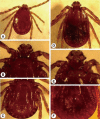Severe tick infestation in a hare and potential risk for transmitting pathogens to humans
- PMID: 22355211
- PMCID: PMC3279682
- DOI: 10.3347/kjp.2011.49.4.419
Severe tick infestation in a hare and potential risk for transmitting pathogens to humans
Abstract
Severe tick infestation was found in a hare in a suburban area of Nanchang, Jiangxi Province, China. We sampled ticks and identified them based on their morphologic characteristics. Three species, Ixodes sinensis, which is commonly found in China and can experimentally transmit Borrelia burgdorferi, Rhipicephalus haemaphysaloides, and Haemaphysalis longicornis which can transmit Lyme disease were detected with an optical microscope and a stereomicroscope. Risk of spreading ticks from suburban to urban areas exists due to human transportation and travel between the infested and non-infested areas around Nanchang.
Keywords: Haemaphysalis longicornis; Ixodes sinensis; Rhipicephalus haemaphysaloides; hare; tick infestation.
Figures




Similar articles
-
Preliminary investigation of ixodid ticks in Jiangxi Province of Eastern China.Exp Appl Acarol. 2019 Jan;77(1):93-104. doi: 10.1007/s10493-018-0324-1. Epub 2018 Dec 12. Exp Appl Acarol. 2019. PMID: 30542968
-
Migratory songbirds disperse ticks across Canada, and first isolation of the Lyme disease spirochete, Borrelia burgdorferi, from the avian tick, Ixodes auritulus.J Parasitol. 2005 Aug;91(4):780-90. doi: 10.1645/GE-3437.1. J Parasitol. 2005. PMID: 17089744
-
Prevalence of Borrelia burgdorferi sensu lato in ticks collected from migratory birds in Switzerland.Appl Environ Microbiol. 2006 Jan;72(1):976-9. doi: 10.1128/AEM.72.1.976-979.2006. Appl Environ Microbiol. 2006. PMID: 16391149 Free PMC article.
-
[The impact of climatic changes on Ixodes (Ixodidae) ticks and their related natural and focal infections].Med Parazitol (Mosk). 2013 Jul-Sep;(3):55-63. Med Parazitol (Mosk). 2013. PMID: 25924291 Review. Russian. No abstract available.
-
The role of Ixodes scapularis, Borrelia burgdorferi and wildlife hosts in Lyme disease prevalence: A quantitative review.Ticks Tick Borne Dis. 2018 Jul;9(5):1103-1114. doi: 10.1016/j.ttbdis.2018.04.006. Epub 2018 Apr 16. Ticks Tick Borne Dis. 2018. PMID: 29680260 Review.
Cited by
-
Tick infestation in human beings in the Nilgiris and Kancheepuram district of Tamil Nadu, India.J Parasit Dis. 2018 Mar;42(1):50-54. doi: 10.1007/s12639-017-0963-x. Epub 2017 Oct 24. J Parasit Dis. 2018. PMID: 29491559 Free PMC article.
-
A sero-epidemiological survey of Chinese Babesia motasi for small ruminants in China.Parasitol Res. 2013 Jun;112(6):2387-91. doi: 10.1007/s00436-013-3310-x. Epub 2013 Feb 1. Parasitol Res. 2013. PMID: 23371500
-
Molecular detection and genetic diversity of Theileria orientalis in cattle in China.Parasitol Res. 2018 Dec;117(12):3689-3694. doi: 10.1007/s00436-018-6023-3. Epub 2018 Jul 28. Parasitol Res. 2018. PMID: 30056555
-
Preliminary investigation of ixodid ticks in Jiangxi Province of Eastern China.Exp Appl Acarol. 2019 Jan;77(1):93-104. doi: 10.1007/s10493-018-0324-1. Epub 2018 Dec 12. Exp Appl Acarol. 2019. PMID: 30542968
-
High genetic diversity in hard ticks from a China-Myanmar border county.Parasit Vectors. 2018 Aug 14;11(1):469. doi: 10.1186/s13071-018-3048-5. Parasit Vectors. 2018. PMID: 30107820 Free PMC article.
References
-
- Goddard J. Infectious diseases and arthropods. 2nd ed. Humana Press; 2008. p. VII.
-
- Pongsiri MJ, Roman J, Ezenwa VO, Goldberg TL, Koren HS, Newbold SC, Ostfeld RS, Pattanayak SK, Salkeld DJ. Biodiversity loss affects global disease ecology. Bioscience. 2009;59:945–954.
Publication types
MeSH terms
LinkOut - more resources
Full Text Sources
Medical
Miscellaneous

